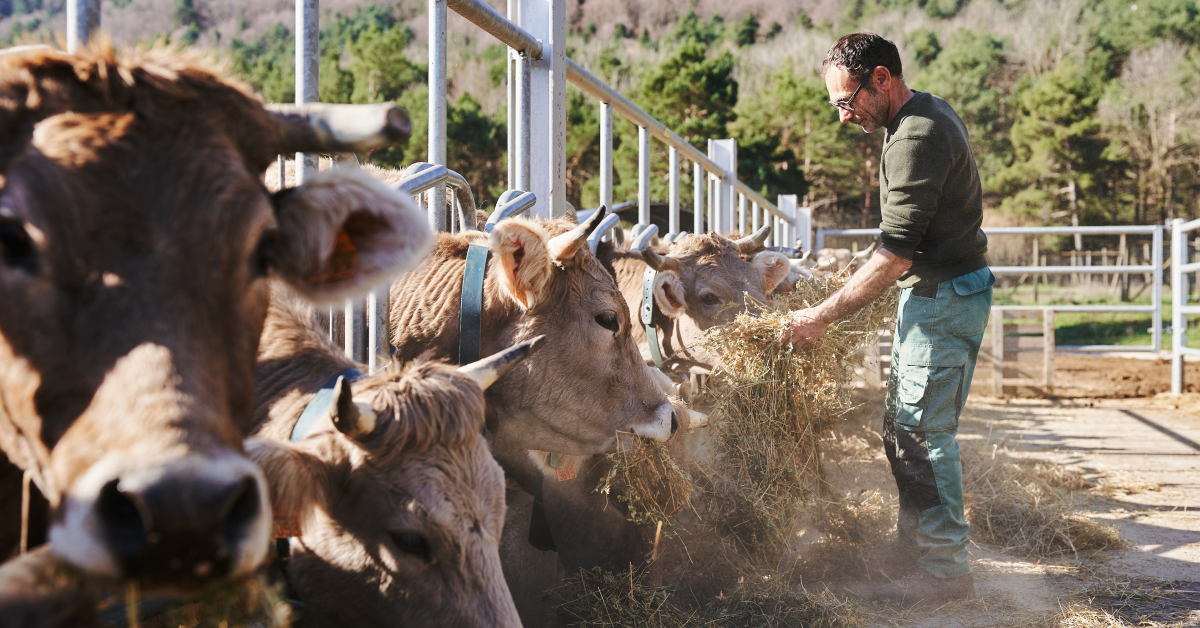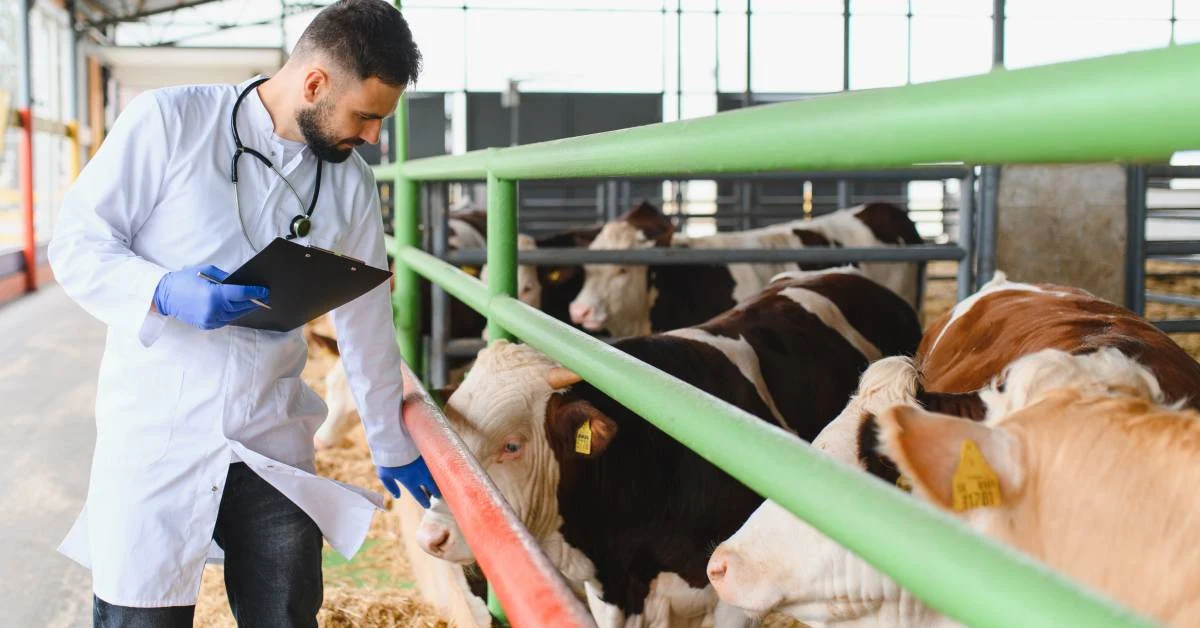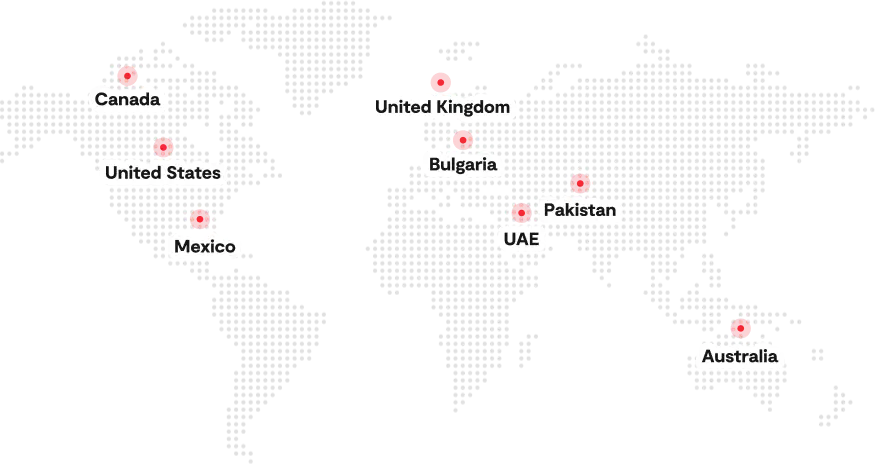In feedlot operations, the way feed rations are designed and managed affects more than just growth rates; it impacts intake behavior, health consistency, and cost efficiency. While ration formulation is backed by decades of nutritional science, applying it correctly in real-world conditions is where most operations diverge.
According to data reported, the average feed-to-gain ratio in U.S. feedlots reached 6.33 in early 2024, up from 6.16 the year before, a sign of declining feed efficiency across the board. That shift may seem small, but over thousands of heads, the cost implications are hard to ignore.
In this blog, we explain the core principles of feed rations for cattle, outline the components that matter most, walk through best practices of real-world feedlots to get better results, and discuss the role of technology for animal nutrition management, from the formulation phase all the way to delivery and refinement.
What Are Feed Rations for Cattle?
Feed rations for cattle are practical plans that specify the types and amounts of feed ingredients given daily to meet the animals’ nutritional needs. Simply put, a feed ration is the total quantity of feed an animal consumes in a day, designed to support its growth, fattening, maintenance, or reproduction goals.
It’s important to distinguish between a ration, a total mixed ration (TMR), and a dry matter basis:
- A ration refers to the daily portion of feed offered to cattle, which can be made up of various feed components served separately or mixed together.
- A total mixed ration (TMR) is a specific feeding approach where all feed ingredients, roughage, grains, protein supplements, minerals, and vitamins, are blended uniformly before feeding. This ensures each bite is nutritionally balanced, promoting consistent intake and reducing selective eating.
- Dry matter basis is a way to measure feed by removing moisture content, allowing accurate comparison of nutrient values across different feedstuffs. Since moisture levels vary widely (for example, fresh forage vs. dry grains), expressing feed on a dry matter basis helps in precise ration formulation and evaluation.
Understanding these distinctions is essential because they influence how feed rations for cattle are formulated and managed to optimize performance. Properly balanced rations provide the right mix of energy, protein, fiber, vitamins, and minerals to fuel muscle development, fat deposition, and maintain digestive health.
For instance, roughage supplies fiber necessary for rumen function, while concentrates deliver energy and protein for growth. An imbalance can lead to poor weight gains, digestive disorders, or increased feed costs.
Components of Optimal Cattle Feed Ration
When it comes to feed rations for cattle, the difference between average and outstanding performance often lies in the details. An optimal ration isn’t just about throwing together ingredients, it’s about understanding how each component interacts and contributes to the animal’s growth, health, and feed efficiency.
Energy Sources
Energy is essential for daily weight gain and feed-to-gain efficiency. In most feedlots, energy is delivered primarily through cereal grains like corn, barley, or wheat. These high-starch feeds are calorie-dense but must be carefully managed.
- Overfeeding starch can reduce rumen pH, triggering acidosis and digestive stress
- Energy from byproducts (e.g., distillers’ grains, beet pulp) offers a safer alternative when combined with effective fiber.
- Energy needs should align with phase-specific goals: starter rations, step-up transitions, and finishing diets all have different thresholds
Protein Sources
Protein is essential for muscle development, immune function, and growth. However, not all protein sources deliver the same value, and not every class of cattle needs the same amount.
In cattle feed rations, protein typically comes from:
- Soybean meal or canola meal (true protein)
- Urea or other NPNs (non-protein nitrogen), used more in finishing phases
Overfeeding protein isn’t just wasteful; it can lead to excess nitrogen excretion, which increases bedding cost, impacts air quality, and raises environmental compliance concerns.
Focus Area:
- Match protein type and quantity to phase: growing cattle may need 13–14% CP, finishers closer to 11–12%
- Avoid unnecessary urea use in starter diets
- Watch for protein-energy imbalance that can reduce gain efficiency
Fibers
In high-concentrate feedlot diets, fiber isn’t a filler; it’s a stabilizer. Physically adequate fiber keeps the rumen active, helps maintain chewing behavior, and prevents acid buildup that leads to bloating and inconsistent intake.
Key fiber sources include:
- Forages like hay, straw, or silage
- Byproduct fiber (e.g., soybean hulls, beet pulp) for more digestible fiber inclusion
Micronutrients
Vitamins and minerals might make up the smallest portion of the ration, but their impact is anything but minor. Trace elements like zinc, manganese, and selenium support immune function and hoof integrity, while vitamins A, D, and E influence fertility and feed conversion.
Rations that are otherwise balanced in protein and energy can still underperform due to micronutrient imbalances.
Checklist:
- Evaluate water mineral content as it affects total intake
- Avoid over-supplementing sulfur and iron, which can bind or block other minerals
- Ensure vitamin stability in stored premixes
Additives and the Role of Feed Mixing Efficiency
Modern feedlots rely on additives like ionophores e.g., monensin, rumen buffers, probiotics, and enzymes to support rumen health and feed utilization. But even the most precise formulation fails if it’s not mixed uniformly.
Feed mixing efficiency is a critical, often overlooked, component of ration delivery:
- A well-mixed TMR ensures every animal gets what the nutritionist intended
- Poor mixing leads to bunk sorting, overfed dominant cattle, and underfed low-rankers
- A Coefficient of Variation (CV) of <5% is the industry benchmark for mix uniformity
Reference: UC Davis Feedlot Uniformity Study
Factors That Influence Feed Ration Formulation
Formulating effective feed rations for cattle is a careful balancing act. Several factors shape how rations are designed to meet the nutritional needs of cattle while optimizing cost and performance. Understanding these influences is key to successful feedlot ration formulation.
1. Animal Characteristics
The type of cattle, whether calves, growing steers, or finishing animals, directly impacts nutrient requirements. Age, weight, sex, and physiological status (such as pregnancy or lactation) determine energy, protein, vitamin, and mineral needs.
For example, a lactating cow requires more energy and protein than a dry cow. Knowing these details allows nutritionists to tailor cattle feed rations precisely to support growth or production goals.
2. Feed Ingredient Quality and Availability
The nutrient composition and quality of available feed ingredients influence ration formulation significantly. Forages vary widely in fiber digestibility and energy content, while grains differ in starch levels and protein quality.
Seasonal changes, storage conditions, and processing methods (like grinding or pelleting) affect palatability and nutrient availability. High-quality ingredients reduce the need for costly supplements, while poor-quality feeds require adjustments to maintain balanced nutrition.
3. Environmental and Management Factors
Climate and housing conditions affect cattle metabolism and feed intake. Hot, humid weather can reduce dry matter intake, requiring rations with higher nutrient density. Similarly, cattle housed outdoors versus in controlled environments have different energy needs. Feeding frequency and management practices, such as group size and feeding equipment, also influence how rations are formulated and delivered.
4. Production Goals and Economic Constraints
Whether the goal is rapid weight gain, maintenance, or reproduction, ration formulation must align with these objectives.
Feedlot operators often balance nutritional adequacy with cost-effectiveness, using least-cost formulation methods while ensuring animal performance isn’t compromised. The cost and availability of feed ingredients play a crucial role in deciding the final ration mix.
5. Nutrient Interactions
Balancing energy, protein, fiber, minerals, and vitamins requires understanding their interactions. For example, excess rapidly fermentable carbohydrates without adequate fiber can cause rumen acidosis. Similarly, mineral imbalances can affect absorption and metabolism.
This complexity makes feedlot ration formulation both a science and an art, often requiring iterative adjustments based on animal response and feed analysis
Common Mistakes in Cattle Feed Rationing
Even when rations are technically sound, their real-world performance can suffer due to small but costly execution errors. Many feedlots unknowingly repeat these issues, resulting in inefficiencies, inconsistent weight gain, and preventable health risks.
Here are some of the most common mistakes seen in feed rations for cattle and how they disrupt the nutritional and economic goals of a feedlot:
1. Ignoring Dry Matter Variability
Relying on “as-fed” values without adjusting for moisture changes, especially in silage or high-moisture byproducts, leads to inaccurate nutrient delivery. This misalignment becomes more visible during weather changes or forage shifts, causing drops in intake and gain.
2. Rushing Grain Finishing Diet Transitions
Feedlots often move cattle too quickly into grain finishing diets, especially when trying to push gains aggressively. This can lead to subacute acidosis, inconsistent feed intake, and reduced feed-to-gain performance, particularly in high-risk pens.
3. Lack of Nutrient Balance in Ingredient Selection
Some operations build cattle rations around a single dominant feed ingredient, like corn or DDGs, without adjusting for excesses or deficiencies in nutrients like sulfur, calcium, or fat. This can impair digestibility, reduce palatability, or trigger metabolic issues.
4. Poor Monitoring of Bunk Behavior
Rationing doesn’t end with delivery. Inadequate observation of bunk behavior, such as leftover feed, rapid cleanout, or sorting, prevents early detection of ration mismatch or digestive problems. These behaviors directly reflect how cattle are responding to the diet.
5. Inconsistent Mixing and Delivery
Uneven mixing causes nutrient segregation in the bunk, leading to overconsumption in dominant cattle and underperformance in low-ranking animals. When mixing efficiency breaks down, the ratio no longer performs as formulated, even if it looks perfect on paper.
Avoiding these mistakes is essential to get the most out of your feedlot ration formulation and protect your margins across every pen.
6. Overlooking Moisture Management in Stored Feed
Moisture levels in stored feed, especially silage or ground hay, can fluctuate over time due to storage conditions, weather, and fermentation. If moisture isn’t monitored and accounted for regularly, it can throw off the actual dry matter intake cattle receive, even when ration formulations appear correct. Without routine moisture checks, feed quality and ration accuracy both suffer.
Best Practices for Feedlot Nutrition Management
Getting feedlot nutrition right is less about formulas and more about execution. It’s a daily process of observation, adaptation, and consistency. Well-planned feed rations for cattle can lose their effectiveness if not delivered, mixed, or adjusted correctly in the pen.
Here’s a look at the practices that make the difference between average yards and top performers:
1. Align Nutrition Strategy with Animal Phase, Not Just Weight
Nutritional needs aren’t just tied to how heavy cattle are; they’re tied to what stage of growth or transition they’re in. This includes:
- Starter Phase: Higher protein and fiber to support gut development and immunity
- Step-Up Phase: Controlled increase in energy while monitoring bunk behavior and rumen health
- Finishing Phase: High-energy, lower-protein diets focused on feed-to-gain efficiency and marbling
What matters most: Don’t treat the ration as static. A ration that worked last week may not work this week if cattle behavior, weather, or feed quality shifts.
2. Build Rations Based on Real Feed Testing, Not Estimates
One of the most overlooked best practices is using updated, lab-tested dry matter and nutrient values, not book averages. Performance becomes unpredictable when feed quality changes and rations aren’t adjusted accordingly.
Use tools like:
- NIR analyzers or commercial labs for forage and byproduct testing
- Dry matter probes for silage before mixing
- Historical quality data for purchasing and rotation planning
3. Prioritize Consistency Over Complexity
A perfectly formulated ration that is inconsistently mixed or delivered is worse than a basic ration executed with precision. Top-tier feedlots often keep their ration strategy simple and reproducible.
Consistency Touchpoints:
- Feed drop times are kept within a tight window (±30 mins daily)
- Mixer loading order and time are standardized
- Bunk calls are data-informed but confirmed visually every morning
4. Track Performance at the Pen Level, Not the Lot Level
Not all pens perform equally, and averaging them out masks opportunities and red flags.
Feedlot nutrition managers who track by pen can spot early signs of ration mismatch, intake fluctuation, or health impact before it spreads.
Examples of actionable pen-level metrics:
- Days on feed vs. gain trend
- Feed intake deviation (especially in hot weather)
- Pull rates for digestive or metabolic issues
- Manure consistency and rumen fill during pen walks
5. Integrate Feedlot Software or Digital Tools
Digital tools aren’t there to replace expertise; they help standardize it. The most consistent yards use feedlot software to reduce human error in mixing, loading, delivery, and intake tracking, areas where even small inconsistencies can erode performance.
Where software adds value:
- Monitoring feed bunk calls over time
- Matching delivered feed to formulated dry matter
- Calculating cost-per-pound-of-gain in real time
- Automating ration adjustments based on performance metrics and weather conditions
Solutions like Folio3’s Cattle Feeding Software help tie all of this together by offering integrated tools for ration tracking, batch-level feed delivery, cost monitoring, and real-time performance insights, making it easier to enforce consistency across pens and across teams. This not only improves execution but also helps feedlot operators improve feed conversion ratio over time by tightening the gap between formulated plans and actual animal intake.
When changes are made to feed rations for cattle, software ensures they’re reflected accurately in execution, not just in formulation. This closes the gap between plan and practice, a difference that often shows up in gain variation, feed waste, or health incidents.
6. Keep the Nutrition Team Loop Tight
Feedlot nutrition isn’t just a one-person job. It’s a team function that involves the feeder, the nutritionist, the bunk reader, and the manager. When communication breaks down, ration execution follows.
What top yards do differently:
- Weekly check-ins with a nutritionist + on-site feeder feedback
- Shared logs of bunk calls, ration changes, and performance notes
- Open communication when health or environmental challenges arise
This tight loop helps ensure that feed rations for cattle evolve in response to what’s actually happening in the yard, not just what was planned in the ration software.
Real-World Perspective with Tech
Even the best-formulated feed rations for cattle can underperform when the operational systems around them lag behind. Cactus Feeders, one of the largest and most respected feedlots in the U.S., faced legacy system challenges. Despite their experience and scale, they faced growing frustration from staff around slow, disconnected systems that made it harder to manage ration delivery, cattle movement, and feed intake tracking.
Folio3 stepped in to overhaul their entire cattle lifecycle, from intake to feed and weight tracking with the help of a feedlot management software, building a faster, more intuitive digital experience across web and mobile platforms. By enabling real-time access to cattle data, feed delivery metrics, and event logs, the team finally had the tools to ensure that feed rations for cattle were being executed with the same precision with which they were formulated.
“The system used to take 7 to 10 seconds just to load a data plane. Now, tasks from feed tracking to movement updates are instant. That alone saved hours across the yard,” shared one of their supervisors.
By digitizing everything from ration adjustments to feed procurement and inventory sync, Cactus Feeders improved efficiency with reduced operational friction that previously distorted ration outcomes. It’s a powerful example of how the right tools can turn best practices into repeatable results.
Conclusion
Feedlot performance doesn’t just hinge on genetics or facilities; it comes down to what’s in the bunk and how reliably it gets there. Well-managed feed rations for cattle translate directly into gain, health, and cost control.
In an environment where margins are tight and expectations are high, ration management isn’t a background task; it’s a strategic advantage. For operations aiming to scale smartly, mastering the delivery and execution of feed rations for cattle isn’t optional; it’s where consistency turns into profit.
FAQs
What is the best feed ration for beef cattle?
The best feed rations for cattle vary by weight, age, and feeding phase. Generally, they combine energy sources like corn, protein supplements, and roughage to support healthy growth and finishing efficiency.
How do you calculate feed rations for cattle?
Feed rations are calculated based on dry matter intake, weight, average daily gain targets, and nutrient needs. Ration formulation tools ensure balanced delivery of energy, protein, and fiber in each pen.
What is a starter vs finisher ration?
Starter rations are higher in roughage and designed to stabilize the rumen and support immune function. Finisher rations shift to high-energy blends that boost efficiency in the final weeks of feed.
What tools are used to manage cattle feed rations?
Tools like feed management software, bunk scoring systems, and dry matter probes help streamline formulation and delivery. These tools ensure that feed rations for cattle are consistent, cost-effective, and data-driven.
Why is dry matter important in cattle rations?
Dry matter tells you the actual nutrient intake regardless of moisture. Without accounting for it, feed rations for cattle can deliver too little or too much energy, impacting performance and health outcomes.







